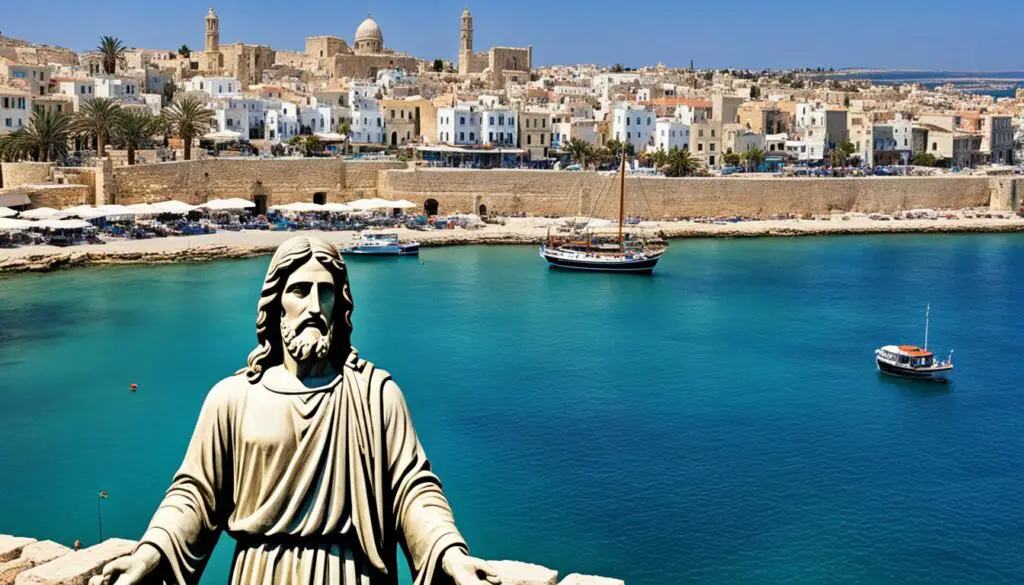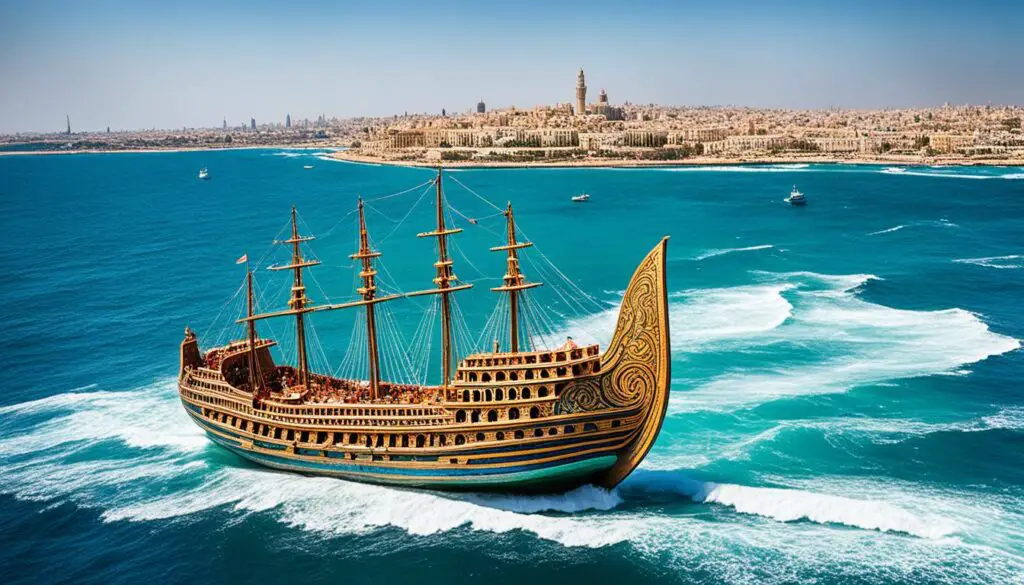Tyre, an ancient city in present-day Lebanon, holds immense historical and biblical importance. This Phoenician city, founded over 4,700 years ago, became a prominent center of maritime trade and production of the luxurious Tyrian purple dye. In the Bible, Tyre is mentioned extensively, with references in both the Old and New Testaments. It played a crucial role in the construction of Solomon’s Temple and served as a symbol of arrogance and pride in prophetic texts.
Despite its past glory, Tyre’s ultimate downfall was prophesied and fulfilled by invading forces, which serves as a testament to the transient nature of earthly wealth and power.
Key Takeaways
- Tyre, an ancient city in present-day Lebanon, has significant historical and biblical significance.
- It was a major center of maritime trade and known for its production of Tyrian purple dye.
- Tyre is mentioned multiple times in the Bible, playing a role in the construction of Solomon’s Temple.
- Prophetic texts highlight Tyre as a symbol of arrogance and pride.
- The city’s downfall was prophesied and fulfilled by invading forces, emphasizing the transient nature of earthly power.
Historical Background of Tyre
Tyre, an ancient Phoenician city located in present-day Lebanon, holds a significant place in history. Founded around 2750 BCE, it became a renowned center of maritime trade and gained prominence for its production of Tyrian purple, a luxurious and expensive dye.
The city of Tyre, with its seafaring expertise and well-protected harbors, played a crucial role in connecting Egypt and the East through its extensive trade routes. It was a hub for maritime negotiations, particularly in the tin trade. Tyre’s strategic location on the coast of the Mediterranean Sea made it a thriving Phoenician city.
Furthermore, Tyre’s historical significance extends beyond its trade and economic prowess. The city is associated with Greek mythologies, believed to be the place of Europa’s kidnapping by Zeus and the birthplace of Europa and Cadmus.
“Tyre, the renowned Phoenician city, flourished as a vibrant center of maritime trade and production of Tyrian purple. Its strategic location and seafaring expertise contributed to its prominence in the ancient world.”
Maritime Trade and Prosperity
The ancient city of Tyre was a bustling hub of maritime trade, facilitating the exchange of goods and cultural interactions between various nations. Its remarkable seafaring skills and knowledge of navigation enabled Tyrian merchants to explore and dominate trade routes throughout the Mediterranean region.
Tyrian Purple: A Color of Royalty
Tyrian purple, a dye derived from a mollusk called the murex, was highly sought-after in the ancient world. Renowned for its vibrant hue and scarcity, this luxurious dye was used to color fabrics and garments worn by the elite. Tyre’s expertise in the production of Tyrian purple contributed to its wealth and prestige.
- Production of Tyrian purple elevated Tyre’s economic status and solidified its reputation as a center of luxury and opulence.
- The Tyrian purple dye was highly valued and became synonymous with royalty and nobility.
- The rigorous process of collecting and extracting the dye from the murex mollusk made Tyrian purple a rare and costly commodity.
In summary, Tyre’s historical background showcases its significance as an ancient Phoenician city renowned for its maritime trade and production of Tyrian purple. This rich history and prosperity have left a lasting impact on the region and contributed to the city’s cultural and economic legacy.
Tyre in The Old Testament
Tyre, an ancient city that holds immense historical and biblical significance, is mentioned multiple times in the Old Testament. Its first reference can be found in the book of Joshua, where it is described as a “strong city.” However, its most prominent role is in relation to King Solomon and the construction of the renowned Solomon’s Temple.
The King of Tyre, Hiram I, played a crucial role in the temple’s construction by providing skilled craftsmen and high-quality materials. This collaboration between Tyre and Israel solidified Tyre’s position as a vital contributor to the religious heritage of the Israelites.
The craftsmen of Tyre were renowned for their skill and expertise, which greatly enhanced the grandeur and magnificence of Solomon’s Temple. Their intricate workmanship and attention to detail are evident in the temple’s exquisite design and craftsmanship.
“And Solomon sent to Hiram, saying, ‘As you dealt with David my father and sent him cedar to build himself a house to dwell in, so deal with me.’” – 1 Kings 5:2
The collaboration between King Solomon and Tyre highlights the importance of unity and cooperation in achieving significant endeavors. It also exemplifies the far-reaching impact of Tyre, a city celebrated for its skilled craftsmen and its contributions to the construction of one of the most iconic structures in biblical history.

The Prophetic Symbolism of Tyre
While Tyre played a positive role in the construction of Solomon’s Temple, it is also symbolized as a city filled with pride and arrogance in several prophetic texts. The book of Ezekiel contains extensive prophecies against Tyre, proclaiming its destruction. The city’s wealth and self-reliance had led to arrogance, causing it to forget the true source of its prosperity. Isaiah and Jeremiah also prophesied against Tyre, foretelling its downfall and the loss of its former status as a prosperous trading hub.
“Thus says the Lord God: Because your heart is proud, and you have said, ‘I am a god, I sit in the seat of the gods, in the heart of the seas,’ yet you are but a man, and no god, though you make your heart like the heart of a god—”
– Ezekiel 28:2 (ESV)
- The arrogance of Tyre led to its downfall.
- Isaiah and Jeremiah prophesied against Tyre.
- Ezekiel’s prophecies detailed the destruction of Tyre.
The Downfall of Tyre
The downfall of Tyre was a direct result of its pride and arrogance. The city’s self-reliance and refusal to acknowledge the true source of its prosperity were seen as an affront to divine authority. The prophetic texts warned of Tyre’s impending destruction, carrying a stern message about the consequences of pride and the transient nature of worldly success.
| Prophetic Texts | Message |
|---|---|
| Ezekiel | Extensive prophecies against Tyre, proclaiming its destruction |
| Isaiah and Jeremiah | Foretold the downfall of Tyre and the loss of its former prosperity |
Tyre in The New Testament
In the New Testament, Tyre maintains its significance as it intersects with important figures in Christianity. Both Jesus and the apostle Paul have notable connections to the city.
Jesus and Tyre
Jesus, during his ministry, visited the region of Tyre, demonstrating the broader impact and message of his teachings. One remarkable event that unfolded during his time in Tyre was the healing of a Syrophoenician woman’s daughter. This miracle showcased Jesus’ compassion and his willingness to extend his divine power beyond the borders of Israel.
It is within Tyre’s boundaries that Jesus, moved by the faith and persistence of the Syrophoenician woman, uttered the words, “For this saying, go your way. The demon has gone out of your daughter.” (Mark 7:29 ESV)
This encounter not only displayed Jesus’ ability to perform miracles but also emphasized his inclusivity and the universality of his message.
Paul and Tyre
Paul, one of the most influential figures in early Christianity, visited Tyre during his final journey to Jerusalem. During his stay, Paul and his companions spent seven days in the city, likely engaging with the local Christian community and deepening their understanding of the faith.
In Tyre, Paul and the believers received a prophetic message, urging him not to proceed to Jerusalem. Despite this warning, Paul’s commitment to his mission led him to continue his journey, ultimately facing challenges and imprisonment. (Acts 21:4-6 ESV)
Paul’s visit to Tyre highlights the city’s ongoing connection to the early Christian movement and its role in shaping the development and spread of the faith.

| Jesus | Paul | |
|---|---|---|
| Visit | Visited Tyre during his ministry | Visited Tyre during his final journey to Jerusalem |
| Event | Performed a miraculous healing | Received a prophetic warning |
| Duration | – | Stayed in Tyre for seven days |
| Significance | Highlighted the universality of his message | Deepened his understanding of the Christian faith |
These encounters between Tyre and significant figures in Christianity underscore the city’s ongoing relevance and connection to the teachings and history of the faith. Tyre’s role in the New Testament continues to exemplify the broader themes of inclusivity, faith, and devotion.
The Fulfillment of Prophesies and the Current State of Tyre
The ancient city of Tyre faced the fulfillment of prophesies that foretold its downfall at the hands of invading forces. The events that unfolded in history validated these predictions, leaving Tyre as a mere shadow of its former glory.
“Thus says the Lord GOD to Tyre: Shall not the coastlands shake at the sound of your fall, when the wounded groan, when slaughter occurs within you?”
Nebuchadnezzar, the mighty King of Babylon, laid a 13-year-long siege to Tyre with the intent of conquering the city. Despite his efforts, Nebuchadnezzar’s siege proved unsuccessful, weakening Tyre but falling short of complete destruction.
“I will make you a bare rock. You shall be a place for the spreading of nets. You shall never be rebuilt, for I am the LORD; I have spoken, declares the Lord GOD.”
However, it was Alexander the Great and his forces that dealt a severe blow to Tyre. Determined to overcome the city’s formidable defenses, Alexander employed a monumental feat of engineering by constructing a causeway to connect the mainland to the island city. This strategic move allowed his army to breach the walls of Tyre and ultimately led to its destruction.

Today, modern-day Tyre exists as a haunting reminder of its majestic past. While it continues to stand in present-day Lebanon, its significance has diminished considerably compared to ancient times. The fulfillment of prophecies against Tyre serves as a testament to the accuracy of biblical predictions, highlighting the transient nature of human achievements and the sovereignty of divine providence.
Historical Significance of Tyre
Tyre’s rich history and contributions to the Phoenician civilization establish its position as one of the oldest and most influential cities in the ancient world. This maritime powerhouse played a pivotal role in shaping the Mediterranean region through its seafaring expertise and expansive trade networks.
Located in present-day Lebanon, Tyre’s rise to prominence can be traced back as early as 2750 BCE. As a Phoenician city, it excelled in maritime trade, earning a reputation for its commercial prowess and substantial influence.
The Phoenicians, known for their nautical expertise, established colonies across the Mediterranean, and Tyre stood at the center of their vast seafaring network. Their ships sailed far and wide, ensuring the free flow of trade and cultural interchange. This relentless pursuit of maritime excellence enabled Tyre to become a dominant force in the ancient world.
One of Tyre’s most enduring contributions was the production of Tyrian purple, a highly sought-after and expensive dye derived from marine snails. This vibrant purple hue adorned the robes of royalty and the elite, symbolizing wealth and power.
Moreover, Tyre’s strategic location provided it with valuable control over vital trade routes, serving as a crucial link between Asia, Africa, and Europe. The city’s well-protected harbors and thriving commercial infrastructure attracted merchants from diverse cultures, contributing to its unparalleled prosperity.
“Tyre’s rich history and maritime power made it a key player in the ancient Mediterranean region, leaving an indelible mark on the Phoenician civilization.”
Tyre’s Contributions to the Phoenician Civilization
| Contributions | Description |
|---|---|
| Maritime Trade | Tyre’s seafaring expertise and extensive trade networks made it a crucial hub in the Phoenician maritime empire, ensuring the prosperity of the entire civilization. |
| Tyrian Purple | The production of Tyrian purple established Tyre as a leading center for luxury goods, symbolizing prestige and wealth. |
| Strategic Location | Tyre’s geographical placement granted it control over important trade routes, enabling the city to thrive as a vital economic and cultural link. |

Geographical Location of Tyre
The ancient city of Tyre was situated in southern Lebanon, on a peninsula that extended into the beautiful Mediterranean Sea. Its strategic location made it a vital hub for maritime activities and trade, connecting various regions and nations.
Tyre was approximately 50 miles south of Lebanon’s capital city, Beirut, and only 12 miles north of the Israeli border. Its proximity to Israel further enhanced its significance as a strategic trading center.

Distance from Key Locations:
| Distance (in miles) | |
|---|---|
| Lebanon’s Capital City – Beirut | Approximately 50 |
| Israeli Border | Approximately 12 |
Tyre’s strategic location facilitated its maritime trade and cultural exchanges with nearby civilizations, making it a thriving city in the ancient world.
Archaeological Discoveries in Tyre
Tyre, with its rich historical heritage, has been a treasure trove of archaeological discoveries, offering valuable insights into various ancient civilizations. Excavations have revealed remnants of the Phoenician, Greco-Roman, Arabic, Byzantine, and other significant cultures that once thrived in the region.
The modern town of Tyre itself is a living testament to the layers of history that permeate its streets. As you wander through its bustling streets, you will come across the remains of the earliest civilizations, standing as a reminder of Tyre’s illustrious past.
Moreover, the peninsula of Tyre is home to several notable archaeological sites that have captivated historians and archaeologists alike. These sites provide a window into the city’s ancient splendor, shedding light on the architectural marvels, cultural practices, and daily lives of the people who inhabited this vibrant coastal city.
From the grandeur of the Phoenician civilizations to the remnants of Greco-Roman influence, the archaeological discoveries in Tyre continue to unravel the mysteries of the past and showcase the enduring legacy of this remarkable city.
Conclusion
The historical and archaeological significance of Tyre in the Bible is undeniable, but its true value goes far beyond that. This ancient city serves as a testament to the moral and religious teachings found in biblical scripture. Through Tyre’s story, we are reminded of the consequences that pride and arrogance can bring.
It is through the prophecies against Tyre and their fulfillment that we witness the prophetic significance of this city. These accurate predictions showcase the divine providence and ultimate power of the teachings within the Bible.
Today, Tyre stands as a lasting legacy, not just of ancient civilizations, but of the transient nature of human achievements. It serves as a powerful reminder that earthly wealth and power are fleeting, and that true significance lies in adherence to biblical principles.







